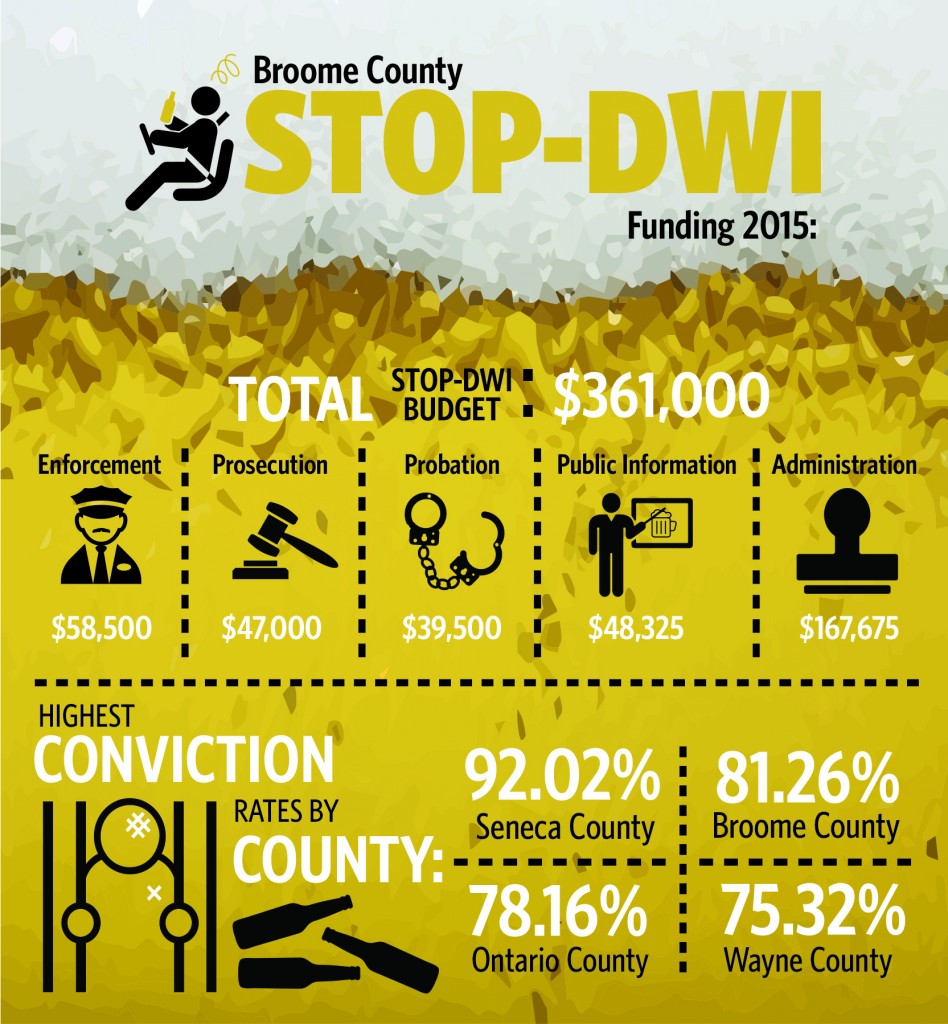
Out of the 62 counties in New York state, Broome County had the second-highest conviction rate for cases of people driving while intoxicated (DWI). And according to law enforcement, that’s a good thing.
Due to funding specifically aimed to combat DWIs both on the streets and in the courtroom, 81.26 percent of cases tried in the county are prosecuted to the full charge, as opposed to a reduced one. This is second only to Ontario County, which boasts a percentage of 92.02. According to District Attorney Gerald Mollen, this is a reflection of the work done by police combining law enforcement and public education.
“The conviction rates we see are directly related to the high quality work of our local and state law-enforcement officers, who are on patrol day and night, detecting and arresting impaired drivers to keep our roads and highways safe,” Mollen said in a press release.
This funding comes from Broome County’s STOP-DWI program, which provides money to local law-enforcement agencies and public information initiatives to help prevent and prosecute drunk driving. It is deployed mainly out of the City of Binghamton Police Department, and was allotted $361,000 in 2015, most of which is paid for by revenue from fines.
Binghamton University Police Department (UPD) lieutenant Steve Faulkner said that the campus’ department also utilized STOP-DWI in combating drunk driving on campus, especially on “busy days” such as Parade Day, the Super Bowl and Halloween weekend.
In 2014, there were 27 DWI arrests made on campus, Faulkner said, which is relatively few.
“In comparison to the number of students that go out to the bars and fraternity parties, the number of students driving drunk is extremely small,” he said. “The buses and taxis being available to the students help keep this number low. For the most part, the students are making the right decision, and being responsible when they go out drinking.”
However, Matthew Jones, a senior majoring in mechanical engineering, said that in his experience living on-campus, the public transportation might be a reason people choose to drink and drive.
“I firmly believe people drunk drive on campus because they hate the public transportation,” he said. “They need to have more comprehensive transportation Downtown on weekends. You have to fight your way onto a bus going Downtown; it’s hell. If you fix that, fewer people will drunk drive.”
Faulkner said the system to catch drunk drivers on campus involves checkpoints and coordinating with local and state police.
When an officer suspects a driver to be driving while intoxicated, they are subjected to a field sobriety test, followed by a blood alcohol concentration test via breathalyzer. If they fail, they are taken to the police station and processed for arrest.
UPD’s approach to tackling the issue is a good one, said Tyler Mehlman, a senior majoring in mechanical engineering. He described an evening when he, the designated driver, was pulled over on campus while driving some friends who had been drinking Downtown.
“They pulled me over for breaking the speed limit and asked me if I had been drinking, or if anyone in the car had been,” he said. “I said yes, and they didn’t ticket me for speeding and told me to be safe and not drink. I thought it was a good thing. Granted I was breaking the rules, but they saw I was being responsible, and I think that’s a good policy.”
He added that those who were driving drunk on campus do deserve to face consequences.
“If you want to drunk drive and get injured, that’s your prerogative,” Mehlman said. “But when you’re potentially hurting others, it becomes something else. Especially on campus where people are walking in the streets. Even during the daytime it’s a mess.”
Faulkner said the combination of education and prosecution is key to keeping students safe on-campus.
“By educating our students, not only on the dangers of drinking and driving, but also on the consequences if they do choose to drink and drive,” he said, “we have been successful in keeping our statistics down.”


